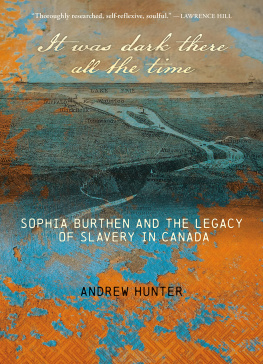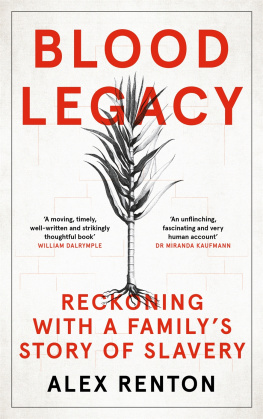Table of Contents
List of Pages
Landmarks

The cover. The top half is a printed image (steel engraving) of a landscape divided by a large river with prominent islands and waterfalls flowing over an escarpment. The runs top to bottom down the middle of the image with a small creek flowing in from right to left joining the main river above the falls. At the top of the image there is a cloudy sky and a lake (marked Lake Erie) in background with a single large ship on it.
Below the image is a geometric pattern reminiscent of African wax prints (ankara) in blue and orange. The text reads: It Was Dark There All the Time: Sophia Burthen and the Legacy of Slavery in Canada by Andrew Hunter. A quote from Lawrence Hill reads, Thoroughly researched, self-reflexive, soulful.
ADVANCE PRAISE FOR It Was Dark There All the Time
A thoroughly researched, self-reflective, soulful meditation on the life of Sophia Burthen, who was enslaved in eighteenth- and nineteenth-century Canada. Hunters book is a searing indictment of the historic and ongoing racism experienced by Indigenous and Black People in Canada and the United States. To read it is to peer into the kind but unflinching heart of a white ally who is committed to recognizing, contextualizing, and confronting injustice in the Americas.
Lawrence Hill, bestselling author of The Book of Negroes
Andrew Hunters deep dive into Canadian and American history goes down trails and pathways not always explored. He has managed to bring to life history that affects us all. Sophia Burthens existence as a Black enslaved child is examined and directs the reader to know her sensitively and intimately. I am grateful to Hunter for ripping apart the archives and finding details that are left unanswered.
Shelley Niro, member of the Six Nations Reserve, Bay of Quinte Kanienkehaka (Mohawk) Nation, Turtle Clan and Governor Generals Award-winning artist and filmmaker
Through the narrative of Sophia Burthen, Andrew Hunter completely reframes Canadian history as well as the history of his hometown Hamilton and turns it on its head. Readers, perhaps for the first time, see the world through the eyes of Burthen and her Black contemporaries, through their plight of enslavement, their liberation, and their presence on these shores. This work, coming at a moment of racial reckoning, is timely and important.
Adrienne Shadd, author of The Journey from Tollgate to Parkway: African Canadians in Hamilton
A dynamic work of unlearning and relearning, researched and written in conversation with Black and Indigenous artists, scholars, historians, and critics past and present. In retracing the steps of Sophia Burthen, a Black woman born in eighteenth-century New York, enslaved by Kanyen'keh:ka (Mohawk) leader Joseph Brant and later sold to Englishman Samuel Hatt, Andrew Hunter unsettles the Hamilton/Dundas of his upbringing a place of cataracts, where an accurate view of history has been obstructed. Chapter by chapter, with archives and anecdotes, Hunter troubles the whiteness he knows he can neither escape nor outperform. Hunters journey makes visible the systemic chalk and fog that continue to mask the fact of chattel slavery from Canadian historical narratives.
Chantal Gibson, author of with/holding
It Was Dark There All the Time is an explosive text in that it explodes the myths of the benevolent north and the haven of Canadian destination. It names and maps in the best senses the land through which the pieced-together narrative of Sophia winds. The book does not strive to contain languages of anyone lost-to-history but instead loudly acknowledges the silence that such loss has left. Its as though by asking the ground itself to bear witness, a reader or a critically committed curator might glimpse a bigger truth or series of truths than history tells. It Was Dark There All the Time journeys literally through our present-day landscape of upstate New York and southern Ontario, a landscape festooned with local museums and roadside historical markers that tell and retell the familiar stories of white conquest and settlement. But the far reach of Hunters book engages both recorded testimonies of nineteenth-century men and women and the voices of contemporary writers to tell the resonances of a larger story, one that continues to exist.
C.S. Giscombe, American Book Award-winning author of Into and Out of Dislocation
Provocatively written, this book promises to destabilize and reshape studies of North American history and culture by struggling directly with how little we still know about the enslaved individuals who shaped our past and present. In sharing the story of Sophia Burthen, a woman of African descent who was kidnapped and enslaved in Canada around the turn of the nineteenth century, Hunter simultaneously tells origin stories of social injustices, environmental emergencies, and other issues troubling our world today. It Was Dark There All the Time joins publications that dismantle the myth of Canada as a colourblind utopia at the end of the Underground Railroad to create narratives that typically have been invisible or erased within official archives. Hunter offers both a critique and a new model of writing history, one that demonstrates the impossibility of authoring a biography about a person who was violently denied connections to her own ancestors and thus her own history.
Layla Bermeo, Kristen and Roger Servison Associate Curator of Paintings, Museum of Fine Arts, Boston
Andrew Hunter has used the so-called blank and in-between spaces of the archive to pen a compelling historic and self-reflexive account of the life of Sophia Burthen, a Canadian enslaved woman. In the midst of a current social amnesia regarding Canadas complicity in both slavery and empire building, Hunter handles Burthens story with care, using her narrative to navigate the complex intersecting ley-lines of empire and its enduring legacy of trauma and erasure. Hunter puts himself in conversation with Burthen, not to centre himself, but to emphasize why Burthens story is all OUR history.
Marenka Thompson-Odlum, Curator, Pitt Rivers Museum, Oxford
It was dark there all the time
SOPHIA BURTHEN AND THE LEGACY OF SLAVERY IN CANADA
ANDREW HUNTER
GOOSE LANE EDITIONS
Copyright 2022 by Andrew Hunter.
All rights reserved. No part of this work may be reproduced or used in any form or by any means, electronic or mechanical, including photocopying, recording, or any retrieval system, without the prior written permission of the publisher or a licence from the Canadian Copyright Licensing Agency (Access Copyright). To contact Access Copyright, visit accesscopyright.ca or call 1-800-893-5777.
Edited by Fazeela Jiwa.
Tracy K. Smith, excerpt from Declaration from Wade in the Water. Originally from The New Yorker (November 6, 2017). Copyright 2017, 2018 by Tracy K. Smith. Used with the permission of The Permissions Company, LLC on behalf of Graywolf Press, graywolfpress.org.
Veronica? from How She Read (copyright 2019 by Chantal Gibson) reprinted with permission of Caitlin Press and the author.
Cover and page design by Julie Scriver.
Cover illustration: Niagara River and Surrounding Country, Showing the Proposed Ship Canal, Rail Roads, &c, Drawn by the late Captain W.G. Williams, U.S. Topographical Corps, detail from Travellers Map of the Middle, Northern, Eastern States and Canada. Showing all the Railroad, Steamboat, Canal and Principal Stage Routes (New York, 1849).
Background elements: (orange and blue texture) Photo boards on unsplash.com; (pattern) Yan Koev, dreamstime.com.









